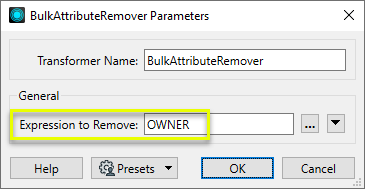FME Transformers: 2025.2
Removes all attributes with names that match a given regular expression. This transformer can be used to remove large numbers of attributes that have common naming patterns.
- Remove multiple attributes from features where the attribute names have something in common, such as a prefix, suffix, string, or a pattern that can be described with a regular expression.
How does it work?
The BulkAttributeRemover lets you enter a regular expression - which may be as simple as a specific series of characters, or as complex as you like, using Advanced Regular Expression syntax.
Any attributes with a portion of their name matching your expression are removed, and all other attributes pass through the transformer untouched.
Matches are case-sensitive.
Examples
In this example, attributes containing the string “OWNER” are removed to anonymize the data.

Non-matching attributes pass through untouched, and the two attributes that do match are removed from the output.

Usage Notes
- Use the AttributeManager to remove selected individual attributes from a feature.
- Use the AttributeKeeper to remove large numbers of attributes without expression matching, and keep selected individual attributes on a feature.
- This transformer will not remove fme_ attributes - to remove them, use either the AttributeRemover or AttributeManager.
Configuration
Input Ports
Features with attributes.
Output Ports
Features with attributes that match the specified regular expression removed.
Parameters
|
Expression to Remove |
Enter a regular expression that specifies what string an attribute name needs to contain for it to be removed. For example, to remove AutoCAD format attributes from a feature, specify: ^autocad_.* Or to remove all attributes containing the string “INTL”, simply enter INTL. You can test expressions by using the Regular Expression Editor, accessed through the drop-down parameter menu. For more information on constructing expressions, see Regular Expression Editor. |
Editing Transformer Parameters
Transformer parameters can be set by directly entering values, using expressions, or referencing other elements in the workspace such as attribute values or user parameters. Various editors and context menus are available to assist. To see what is available, click  beside the applicable parameter.
beside the applicable parameter.
Defining Values
There are several ways to define a value for use in a Transformer. The simplest is to simply type in a value or string, which can include functions of various types such as attribute references, math and string functions, and workspace parameters.
Using the Text Editor
The Text Editor provides a convenient way to construct text strings (including regular expressions) from various data sources, such as attributes, parameters, and constants, where the result is used directly inside a parameter.
Using the Arithmetic Editor
The Arithmetic Editor provides a convenient way to construct math expressions from various data sources, such as attributes, parameters, and feature functions, where the result is used directly inside a parameter.
Conditional Values
Set values depending on one or more test conditions that either pass or fail.
Parameter Condition Definition Dialog
Content
Expressions and strings can include a number of functions, characters, parameters, and more.
When setting values - whether entered directly in a parameter or constructed using one of the editors - strings and expressions containing String, Math, Date/Time or FME Feature Functions will have those functions evaluated. Therefore, the names of these functions (in the form @<function_name>) should not be used as literal string values.
| These functions manipulate and format strings. | |
|
Special Characters |
A set of control characters is available in the Text Editor. |
| Math functions are available in both editors. | |
| Date/Time Functions | Date and time functions are available in the Text Editor. |
| These operators are available in the Arithmetic Editor. | |
| These return primarily feature-specific values. | |
| FME and workspace-specific parameters may be used. | |
| Creating and Modifying User Parameters | Create your own editable parameters. |
Table Tools
Transformers with table-style parameters have additional tools for populating and manipulating values.
|
Row Reordering
|
Enabled once you have clicked on a row item. Choices include:
|
|
Cut, Copy, and Paste
|
Enabled once you have clicked on a row item. Choices include:
Cut, copy, and paste may be used within a transformer, or between transformers. |
|
Filter
|
Start typing a string, and the matrix will only display rows matching those characters. Searches all columns. This only affects the display of attributes within the transformer - it does not alter which attributes are output. |
|
Import
|
Import populates the table with a set of new attributes read from a dataset. Specific application varies between transformers. |
|
Reset/Refresh
|
Generally resets the table to its initial state, and may provide additional options to remove invalid entries. Behavior varies between transformers. |
Note: Not all tools are available in all transformers.
For more information, see Transformer Parameter Menu Options.
Reference
|
Processing Behavior |
|
|
Feature Holding |
No |
| Dependencies | None |
| Aliases | AttributeExpressionRemover |
| History |
FME Online Resources
The FME Community and Support Center Knowledge Base have a wealth of information, including active forums with 35,000+ members and thousands of articles.
Search for all results about the BulkAttributeRemover on the FME Community.
Examples may contain information licensed under the Open Government Licence – Vancouver, Open Government Licence - British Columbia, and/or Open Government Licence – Canada.




